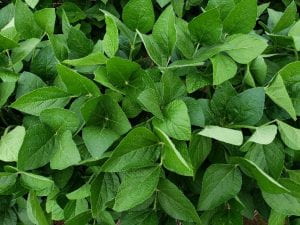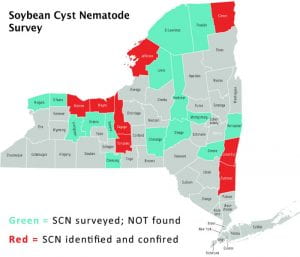Soybean Harvest Aids

Photo: M. Stanyard / CCE NWNY Team
Many of the early maturity soybeans have been harvested and plenty are starting to turn yellow. One thing that has been really noticeable is the amount of weedy soybean fields. There are plenty of foxtail, lambsquarters and marestail that are way above the beans and still green. Much of this was due to the dry conditions around the region and rows that never completely closed canopy. By the time harvest occurs the weed seeds will probably be mature but how tough will harvest be with all of those weeds still growing? There are a couple products we can apply as harvest aids but it is usually only for weed burndown not speed up plant maturation. Many of the herbicide label restrictions do not allow application until plants are fully mature. Below is a list of labeled herbicide options from Penn State Extension with important restrictions from the label. Here is the link to the full article, https://extension.psu.edu/harvest-aid-options-in-corn-and-soybeans.
- Aim 2EC — Apply 1.5 fl oz/acre as a harvest aid to desiccate certain broadleaf weeds. Application shall be made when the crop is mature and the grain has begun to dry down and at least 3 days before harvest. Apply in 10 gal/A water. Include necessary adjuvants and make sure spray coverage is sufficient otherwise poor control will result. Do not feed treated soybean forage or hay to livestock.
- Clarity — Apply 8 fl oz to 2 quarts after soybean pods have reached a mature brown color and at least 75% leaf drop has occurred. Wait at least 7 days before harvest. Use a non-ionic surfactant or crop oil concentrate plus nitrogen solution in the spray solution. Do not feed soybean fodder or hay following a preharvest application.
- Defol 5L — Can be applied to desiccate problem weeds in early maturing soybean. Apply 4.8 qt/acre, 7-10 days before harvest in 20 gallons/acre water. No adjuvant is recommended. Do not graze treated field or feed treated fodder.
- Glyphosate — For pre-harvest, glyphosate may be applied to Roundup Ready and conventional soybeans after 80% leaf drop (loss of all green color). Apply up to 0.75 lb ae/acre (32 fl oz of a 3 lb ae/gal formulation) in 10-20 gallons of water/acre to control weeds that may interfere with harvest or to control perennials such as quackgrass or Canada thistle but will not control glyphosate-resistant weeds or dry down Roundup Ready varieties. Allow a minimum of 7 days between application and harvest. Use of a non-ionic surfactant plus ammonium sulfate in the spray solution may improve control. Do not graze or harvest the treated crop for livestock feed within 25 days of application. Do not use on soybeans grown for seed.
- Gramoxone SL — Apply 8 to 16 fl. oz/acre plus nonionic surfactant (1 qt/100 gallons of spray) to soybean plants that are mature (65% or more of the seed pods have reached mature brown color or seed moisture is 30% or less. Do not apply within 15 days of harvest and do not graze or harvest for forage or hay.
- Sharpen — Apply 1 to 2 fl. oz/acre after physiological maturity when greater than 50% leaf drop has occurred, and remaining leaves are yellow and at least 3 days before harvest. Include MSO plus AMS or UAN to improve performance.
New York September Corn and Soybean Forecast

ALBANY, NY — The USDA-NASS has released the crop production forecast for September, according to Donnie Fike, state statistician of the USDA’s National Agricultural Statistics Service (NASS), New York Field Office. The latest survey, which was conducted during the last week of August and the first week of September, included the following commodities:
Corn production is forecast at 82.7 million bushels, down 4 percent from 2019. Based on conditions as of September 1, yields are forecast to average a record high 167.0 bushels per acre, up 9 bushels from the 2019 average. Area harvested for grain is forecast at 495 thousand acres, down 9 percent from 2019.

Soybeans production is forecast at 13.7 million bushels, up 27 percent from 2019. Based on September 1 conditions, yield is forecast to average 49.0 bushels per acre, up one bushel from last year. Area for harvest is forecast at 280 thousand acres, up 55 thousand acres from 2019.
Production forecasts are released on a monthly basis and do not reflect final production estimates. The next production forecast will be issued October 9, 2020.
Monitoring for Soybean Cyst Nematode in Northwest New York

The soybean cyst nematode (SCN) is considered the single largest cause of nationwide soybean yield losses. The nematode was first found in Cayuga County in 2016 after four years of actively surveying field soils in 17 counties from western to northern NY counties (2014-2016).
In 2019 a Cooperative Agricultural Pest Survey (CAPS), sponsored by NYS Department of Ag. and Markets found seven more positive areas. Two of these fields were in the NWNY region (Monroe and Wayne Counties). The below map summarizes the activities and the outcomes of surveys. This fall, additional counties will be sampled, assisted by the CAPS program and the NY Corn and Soybean Growers Association.

Source: Craig Grau, University of Wisconsin.
The best way to confirm SCN is to scout soybean fields with symptoms, dig plants, look for cysts on the roots, and submit a soil sample for testing and confirmation. We are looking to sample 2-3 fields per county within the NWNY region and test for SCN. If you see uneven patterns in your soybean field or suspect an issue, contact Mike or Jodi for a field visit. Additional resources about SCN can be accessed at: https://www.thescncoalition.com/resources/tools-to-download.


